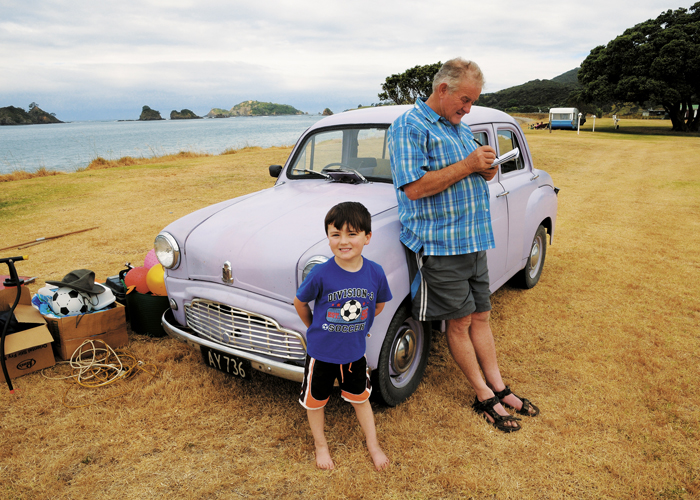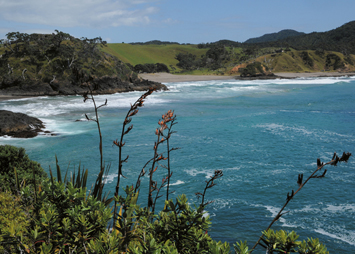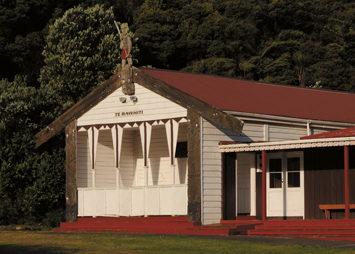
Mimiwhangata road trip
The curly gravel road passes meadows white with cow parsley. Old-fashioned red roses that escaped from gardens decades ago ramble along farm fences.
Skylarks, black dots high in the sky, sing for the joy of summer. Then the road threads through patches of lush bush, past nikau groves and giant puriri in shady valleys. It is an Edenesque entry to a heavenly place. Mimiwhangata: I want to go there because I love the sound of the name.
At the end of the gravel road is a 2,000-hectare coastal park surrounded by a marine reserve. The park straddles a peninsula with Mimiwhangata Bay on one side, with its curve of golden sand and gentle waves, and sandy coves separated by little rocky headlands on the other.
In a country with an abundance of gorgeous coastline, this is exceptionally beautiful and, strangely, considering popular Paihia and Russell are just an hour’s drive away, it’s almost deserted. We walk along the beach and decide, now we know the glories at the end of the road, that we will come back with camping gear and more food than a thermos of tea and a packet of Gingernuts.
Mimiwhangata is a hard act to follow. The beach communities of Helena Bay and Oakura seem relatively lacklustre, not helped by a strong easterly roughing up what might be otherwise pretty sea. The store at Oakura, the only one on this stretch of road, is an old-time treasure – small, busy and stocking a little of absolutely everything. We fill up with petrol and do a quick round up of essentials to keep us fed for the next two days.
Bland Bay, a half-hour drive from Oakura around the finger of Whangaruru Harbour, is a perfect horseshoe. Much of it is taken up by a large camping ground and in the middle of it, beach-side, I meet Carol and William Davis and family, who are old-time campers.
Their Bland Bay love story began 34 years ago when, both solo parents, they bundled up their kids and headed north from home in West Auckland.
“There were gravel roads most of the way and it took hours. We often had to stop when the cars boiled over,“ says Carol. “But when we came over the hill and saw Bland Bay, blue and shining below us, it was magic. It’s isolated, a safe beach and great for kids.

“The days disappeared with walking, swimming, fishing and picnics, and the kids played in herds, socialising with others who regularly camped here. On wet days I sat in the tent and did paint-by-numbers, something I never had time for at home.”
Now they come up twice a year with grandkids, some of whom enjoy helping William tinker with his 1950 Standard 10. Their canvas tent is 1960s vintage and they don’t want a silly new-fangled one. “It’s got no floor, but we have a big ground sheet. When it rains, if water gets in, we just pull up the sides and sweep it out, and when it’s too hot we roll up the walls and catch the breeze.”
In comparison to the Davis family I’m a lush and opt for a soft bed and ensuite bathroom. We find just the thing 10 minutes away at Pawhaoa Bay Lodge. The guest villa looks west over Whangaruru Harbour and we join our hosts, Claire and Bill Hurst, near the water’s edge for drinks and nibbles so substantial that they turn into dinner. We chatter while the sun sinks in a visual feast, including silhouetted layers of hills and orange-edged clouds pierced by Jacob’s ladders. Nothing beats a good sunset.
It’s only 25 kilometres to Rawhiti, but it takes us all day to get there.
Easterly winds make local surfers happy and at Taupiri it’s pumping. Three bays are separated by bush-covered headlands and, because the first one is busy, enthusiasts with wetsuits rolled down and boards tucked under their arms sprint past us, up the ridge and down to the next bay. They paddle for waves but miss, catch waves and fall spectacularly and, sometimes, catch a wave, surf with astonishing skill and dexterity to finally swoop back, behind the expiring wave, then paddle out and catch another.
This is another glorious coastal walk, with bunny tails dancing and spinifex and stunted pink convolvulus holding on, flowering in wind-blown sand. There are both wild waves and sheltered rock pools for swimming. I choose the latter and marvel that all this is free, except for the gold coin donation at the private-land car park.

Rawhiti is a series of waterside hamlets on the inland edge of a peninsula that marks the southern entry to the Bay of Islands. Ancient tractors lie waiting to launch boats from trailers, baches with serial build-ons and caravans attached to sheds decades ago are still loved and lived in over summer. Rope swings dangle from pohutukawa trees and pulled-up dinghies lean on grassy banks. The Rawhiti marae has its own cove and, beyond it, a path leads uphill to the urupa, the cemetery where those whose hearts are still here rest with glorious views.
From here, fitter people than I turn right for the nine-hour walk to Cape Brett. In this still-cool morning, I turn left and follow the ridge path toward the end of the peninsula. On one side there is a steep drop to deep blue sea rising and falling, swirling around wet rock. On the other, second-growth bush slopes down to the road and the straggle of Rawhiti. The sound is sublime stereo: the rhythmic swish of waves in one ear and birdsong in the other. Tui, fantails, thrushes and grey warblers all celebrate morning in their own way. There is a flash of scarlet and lime as a pair of rosellas fly by squawking, and gannets dive with a purposeful splash. An arrow of silver cuts into the morning, as a fast boat zooms over still water leaving a long comet tail.
The path and peninsula end above Kaimarama Bay, where I take a breather under a red pohutukawa so full of bees collecting nectar that the tree hums louder than the lapping of little waves. Ahh, Northland; I love it.
How to get there
Mimiwhangata, in Helena Bay, is 50km north-east of Whangarei. It's approximately 60km from Mimiwhangata to Rawhiti. The roads are not sealed at either end of the journey.
Where to stay
- Mimiwhangata and Bland Bay have camping grounds in superb locations - see the DoC website
- Pawhaoa Bay Lodge is on the beach, 10 minute's drive from Bland Bay
Reported by Liz Light for our AA Directions Summer 2011 issue
